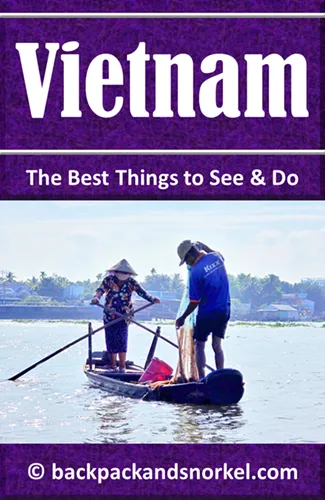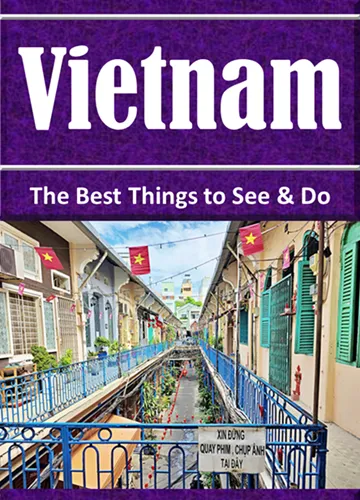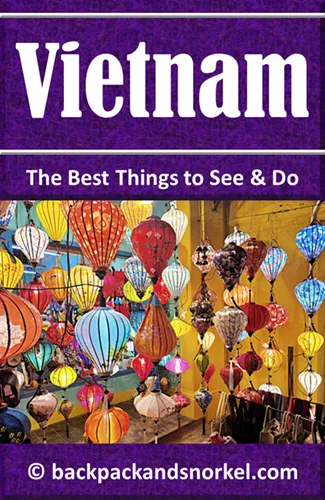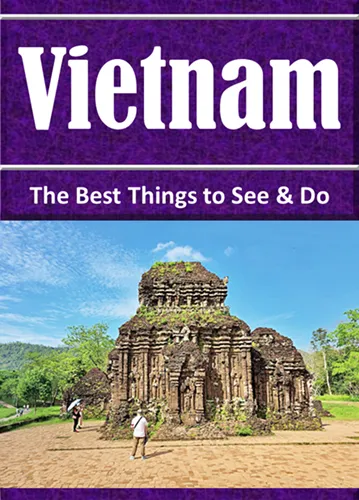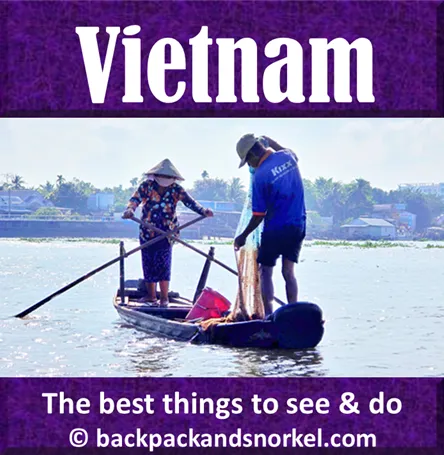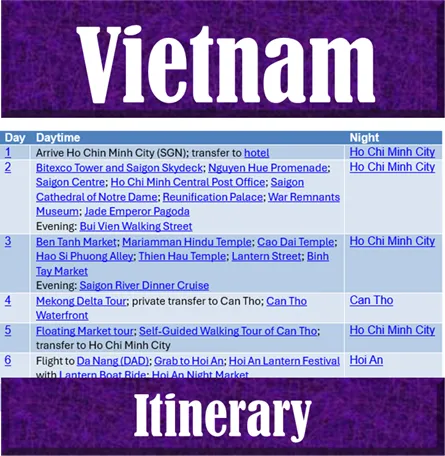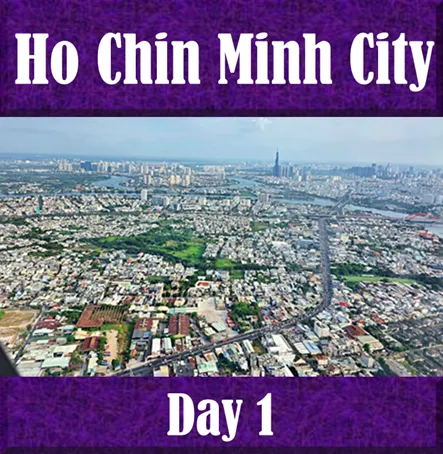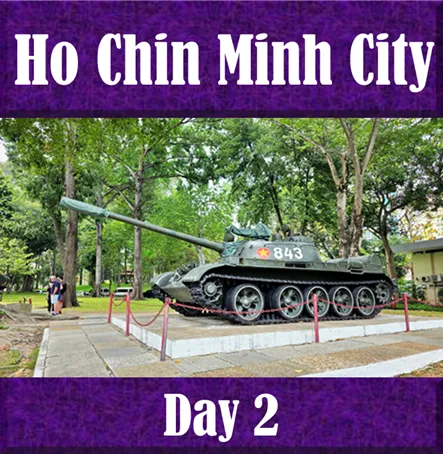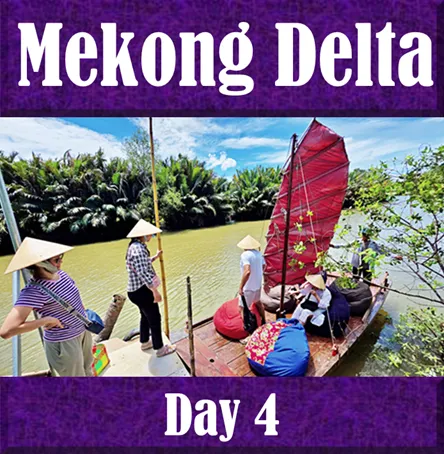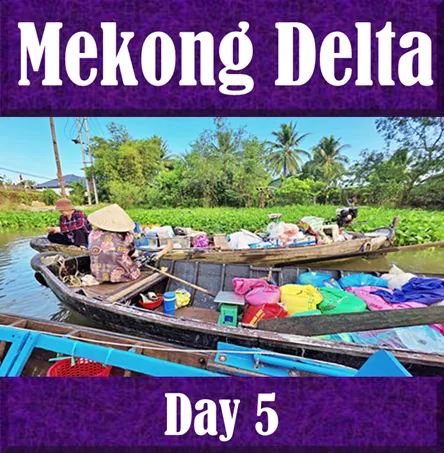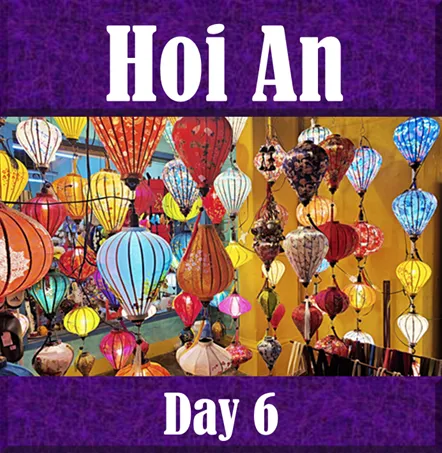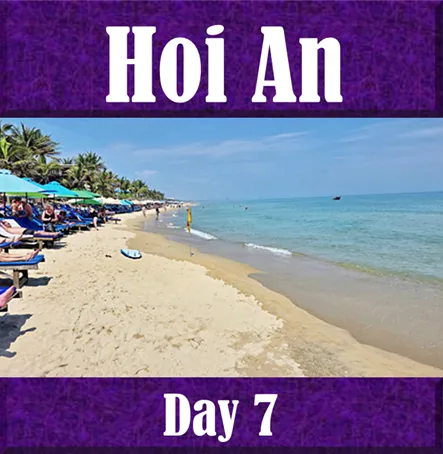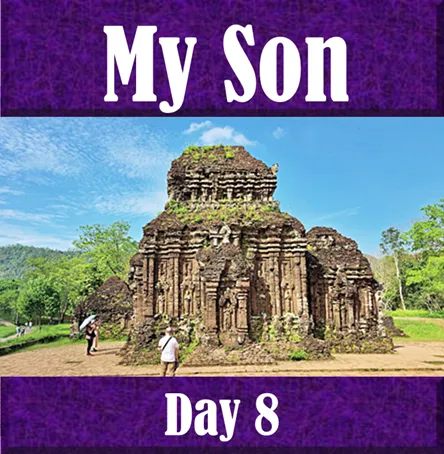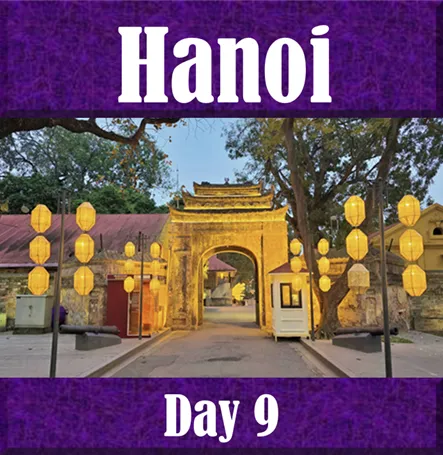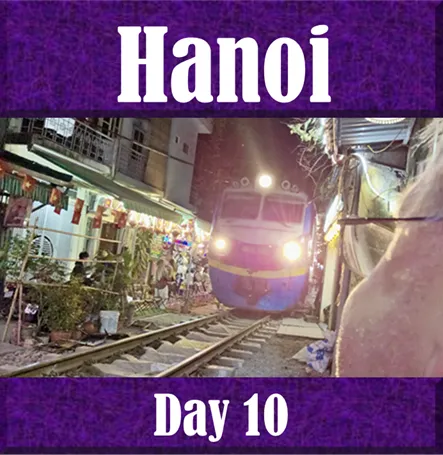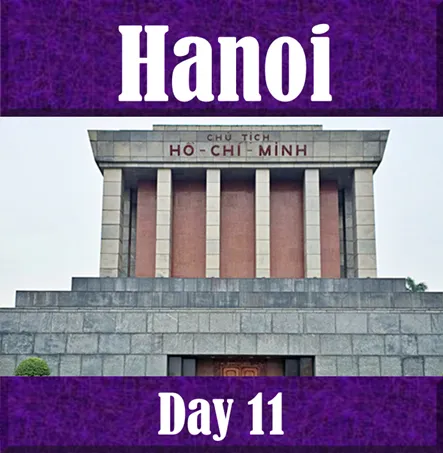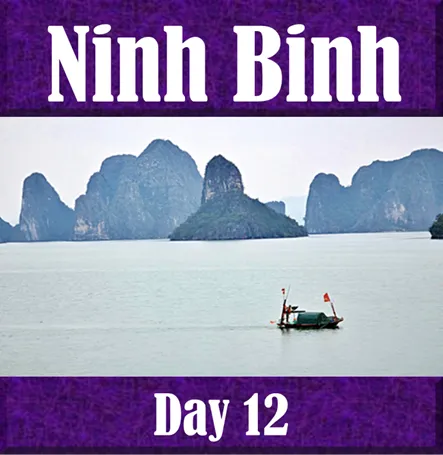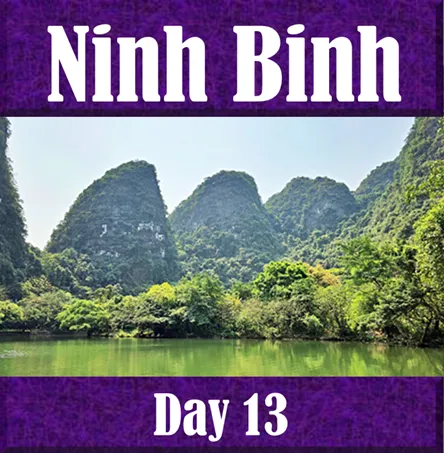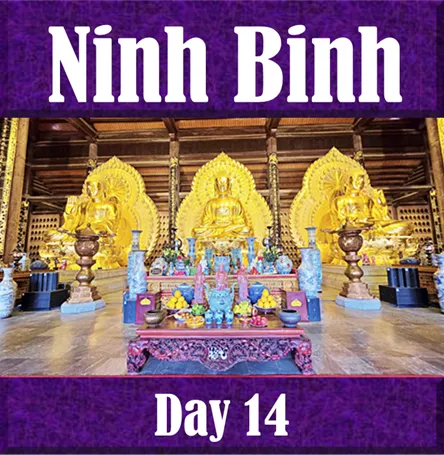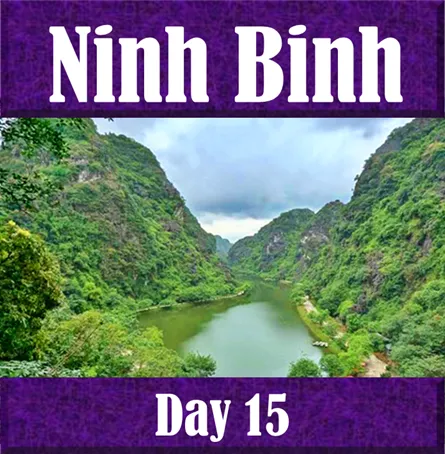Trang An Boat Tour Guide near Ninh Binh: Routes, Caves, and Tam Coc vs. Trang An Comparison | Vietnam Purple Travel Guide
Today is your first full day in the Ninh Binh area. We will make good use of our time, as we will visit three of the absolute highlights in this area: Trang An Boat Tour, Hang Mua Cave, Hoa Lu Old Town. By far the best way to get to the individual attractions today and tomorrow is by using Grab.
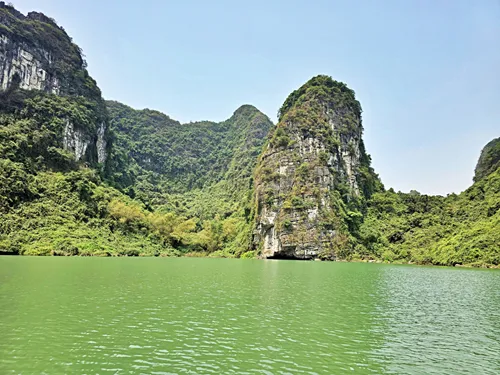
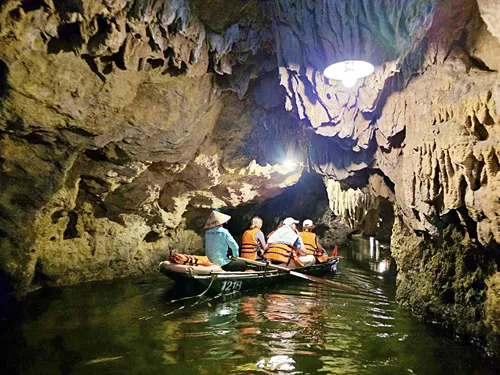
Here at Backpack and Snorkel Travel Guides, we promote self-guided walking tours.
But we realize that not everybody likes to walk by themselves in a foreign city. So, just in case that you rather go with ab guide: NO PROBLEM! Please see the Viator tours below.
paid Viator tours
Tam Cốc vs. Tràng An: Which Boat Tour Should You Choose in Ninh Bình?
Both Tam Cốc and Tràng An are spectacular destinations in Ninh Bình Province, offering unforgettable boat tours through breathtaking limestone karst landscapes. Often dubbed ‘Ha Long Bay on land’, both sites feature winding rivers, lush rice fields, and mysterious caves, and both are accessible within a few hours from Hanoi.
However, while they seem similar on the surface, these two boat tours offer distinct experiences, and most visitors tend to strongly prefer one over the other. Below is a side-by-side comparison to help travelers choose the best fit for their interests and travel style:
Feature |
Tràng An |
Tam Cốc |
|---|---|---|
Duration |
2–3 hours |
1.5–2 hours |
Number of Caves |
6–9 caves depending on route |
3 caves |
Temples Included |
Multiple temples (Trình, Trần, etc.) |
None or optional visits on land |
UNESCO Status |
Yes (Mixed Cultural & Natural Site) |
No (Part of wider Ninh Bình region) |
Boat Style |
Wooden sampan (up to 4 people) |
Wooden sampan (2–4 people) |
Landscape |
Jungle-lined cliffs, tranquil valleys |
Rice paddies, open karst scenery |
Experience Type |
Spiritual, serene, immersive |
Rustic, open, lively |
Rowers' Reputation |
Friendly, polite, professional |
Sometimes pushy, insistent, and rude |
Crowds |
Less crowded and well-organized |
Busier and more commercialized |
Tràng An Boat Tour: Peaceful, Cultural, and Deeply Spiritual
Tràng An is widely regarded as the more peaceful, scenic, and culturally rich of the two options. It is part of a UNESCO World Heritage Site, thanks to both its geological beauty and its rich historical context. Visitors here glide through long, dark caves, past jungle-covered mountains, and stop at ancient temples that date back to the 10th century.
One of Tràng An’s highlights is the variety of three different boat routes, each offering a unique combination of caves, temples, and landscapes. These routes tend to be less crowded, with professional rowers who rarely pressure passengers for tips or sales.
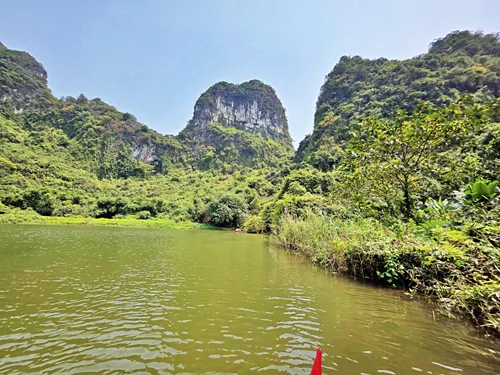
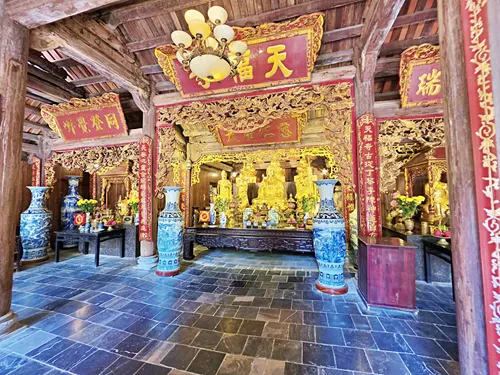
Tam Cốc Boat Tour: Rustic Scenery and Rice Fields—But Mixed Reviews
Tam Cốc, meaning ‘Three Caves’, is known for its open views of the countryside, particularly when the rice fields are green or golden (typically in May or early June). The river winds through open valleys and three cave tunnels, with dramatic karst cliffs towering nearby.
The scenery is undeniably beautiful, especially when viewed under soft light with green fields stretching into the distance. However, the overall experience is more hit-or-miss due to:
Aggressive vendors: Rowers sometimes stop the boat in the middle of the river to pressure tourists into buying snacks, drinks, or embroidery, sometimes refusing to move unless something is purchased.
Demanding tipping behavior: Some boat operators become rude or even hostile if tourists do not tip enough or buy items.
Overcrowding and noise: On weekends or during high season, Tam Cốc can become congested with dozens of boats, diminishing the tranquil atmosphere.
If you come at the right time of year (typically in May or early June) when the rice paddies are blooming in a golden-yellow hue, then you will have absolutely stunning views. During the rest of the year, they either just blend in or look barren after the harvest.
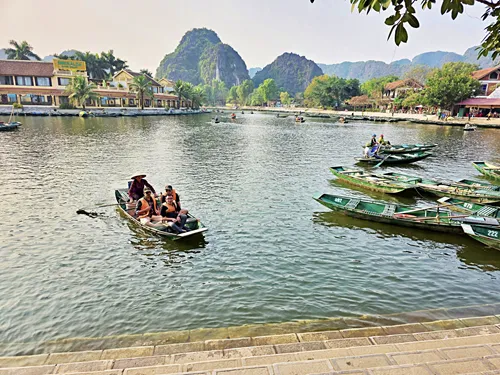
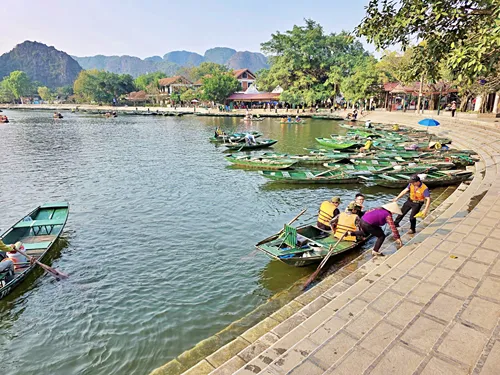
Which Tour Is Right for You?
Choose Tràng An if you want:
A longer, more varied boat experience through natural caves and sacred temples
A quiet, non-commercialized environment
An experience that reflects Vietnam’s spiritual and historical identity
A professional, respectful atmosphere with friendly boat rowers
Choose Tam Cốc if you want:
A shorter tour focused on open rice field scenery
Good seasonal photography (especially during rice harvest in late May/June)
A more lively, rural local vibe and do not mind the occasional sales pressure
Trang An Boat Tour – A Journey Through Vietnam’s Natural and Spiritual Heritage
(map, reviews)
This is Premium Content! To access it, please download our
Backpack and Snorkel Purple Travel GuidePrice: 250,000 VND per adult at the time of writing
Boat capacity: 4 adults (or a mix of 2 adults + 2 children)
Operating hours: 7:30 AM to 4:00 PM daily (last departure around 3:30 PM)
Tips for Your Visit
Early morning or late afternoon offers the best light and fewest crowds.
Weekdays: If possible come Mondays through Fridays, as weekends and especially Sundays can be extremely busy
Bring sunscreen, water, a hat, and a light raincoat (boats are uncovered).
Dress modestly if you plan to enter temples.
Tips for boat rowers are appreciated (we suggest 50,000 VND).
The Trang An Landscape Complex, located in Ninh Bình Province, is one of the most breathtaking and historically rich destinations in Vietnam. Designated a UNESCO World Heritage Site in 2014 for both its cultural and natural significance, Trang An is often called ‘the Ha Long Bay on Land’ for its majestic limestone karst formations rising from lush valleys and winding rivers. The best way to explore this ethereal landscape is by sampan boat, steered by skilled local rowers, gliding through a tranquil maze of caves, rivers, and ancient temples.
What makes Trang An especially remarkable is that the tour is not just scenic – it is immersive. Visitors travel through a waterway system, entering narrow caves by boat, passing under stone arches, and disembarking at isolated temples nestled deep within valleys that have remained largely unchanged for centuries.
The Three Official Trang An Boat Tour Routes
When visiting Trang An, you have to first buy a ticket in the buildings to the north of the road (map), and then walk through the tunnel and over the bridge to the Trang An Boat Dock (map) where you tell the operator which of the three different boat routes, each lasting around 2 to 3 hours covering slightly different cave and temple combinations, you want to take. All tours start from the Trang An Boat Dock, and each sampan accommodates up to four passengers.
This is Premium Content! To access it, please download our
Backpack and Snorkel Purple Travel GuideThis is Premium Content! To access it, please download our
Backpack and Snorkel Purple Travel GuidePlease see the next pages for descriptions of all three boat tours. Most visitors choose Route 1.
Please find details of Route 2 and Route 3 here.
At each temple, your boat will stop, giving you ample time to explore it.
Each boat has some oars that you can use if you like to help propel the boat. This is completely voluntary.
Because the lady who will row your boat will work very hard, we suggest giving her at least a 50,000 VND tip per person.
Route 1: The Classic & Most Spiritual Route
Duration: 2.5 to 3 hours
Caves visited: 9 caves
Temples visited: 3 temples
Best for: Visitors interested in temples, legends, and the area’s historic atmosphere
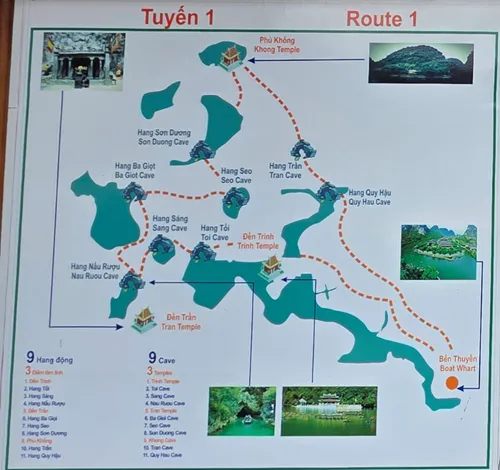
Trình Temple
Dedicated to General Nguyễn Minh Không, a revered figure in Vietnamese history and medicine, Trình Temple is one of the oldest and most venerated temples in the Trang An Complex. It symbolizes loyalty to the Đinh kings, ancestral worship, and the enduring presence of guardianship in Vietnamese cosmology. Locals still make offerings here for protection and healing.
Here are some photos that we took: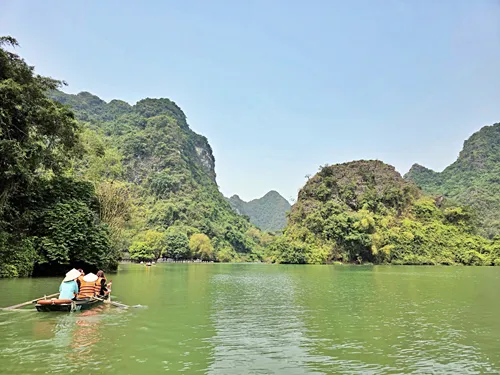
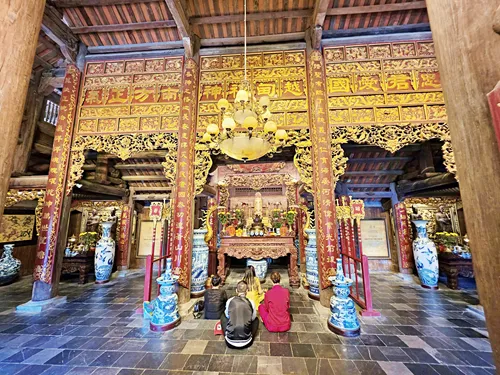
Hang Tối (Dark Cave)
This cave’s name reflects the darkness of the unknown and the symbolic journey through inner stillness and reflection. In Vietnamese belief, darkness is not feared but embraced as part of balance. Visitors are encouraged to move quietly, listening to nature and embracing the meditative quality of the space.
Here are some photos that we took:
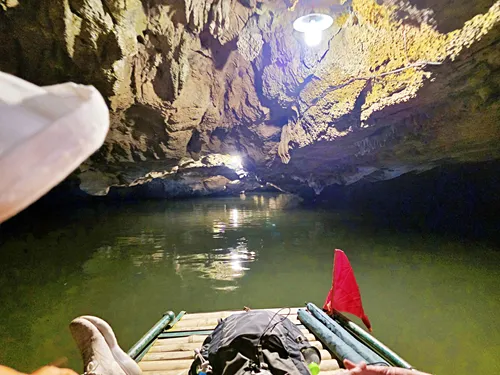
Hang Sáng (Bright Cave)
Entered after Hang Tối, Hang Sáng serves as the symbolic emergence into light: hope, clarity, and renewal. The passage between dark and light is seen as a spiritual metaphor for enlightenment and wisdom in Vietnamese Buddhist-influenced thought.
Here are some photos that we took: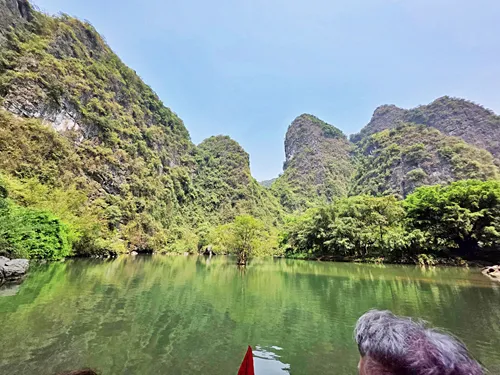
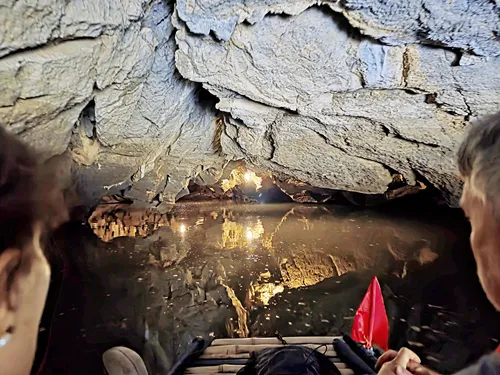
Hang Nau Ruou (Wine-Brewing Cave)
According to local legend, Hang Nấu Rượu was once used by royal brewers during the time of the Đinh Dynasty (10th century), when Hoa Lư served as Vietnam’s imperial capital. The spring deep within the cave was said to produce exceptionally pure water, perfect for distilling high-quality rice wine for the royal court.
The name ‘Nấu Rượu’ literally means ‘cooking wine’, and it is believed that brewers would haul rice and ingredients into the cave, ferment them in urns, and age the wine in the natural coolness of the rock-walled interior. This made the resulting product uniquely smooth and strong—worthy of kings and ceremonial offerings.
Some tales go even further, claiming that the wine brewed here was infused with medicinal herbs and served as a kind of sacred elixir during coronation rituals or spiritual rites.
Here are some photos that we took: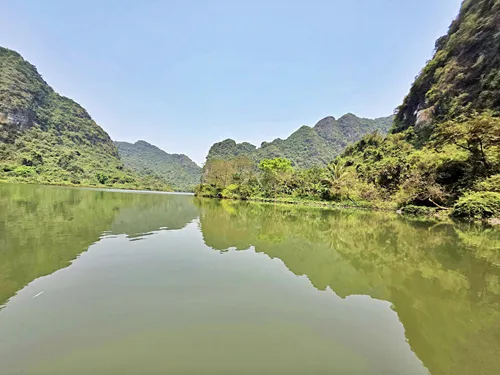
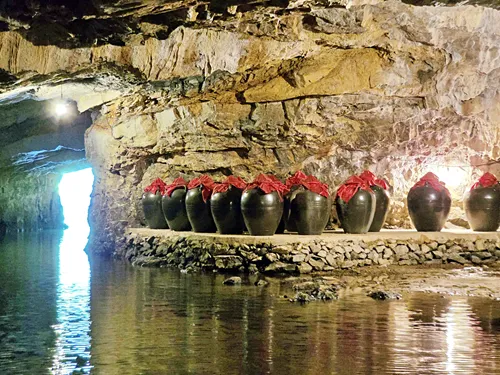
Đền Trần (Trần Temple)
Built to honor Trần Hưng Đạo, the national hero who led Vietnam to victory against Mongol invasions, this temple is a patriotic and spiritual landmark. Offerings here reflect themes of strength, national pride, and ancestral protection, and the temple serves as a place of prayer for courage and resilience.
Here are some photos that we took: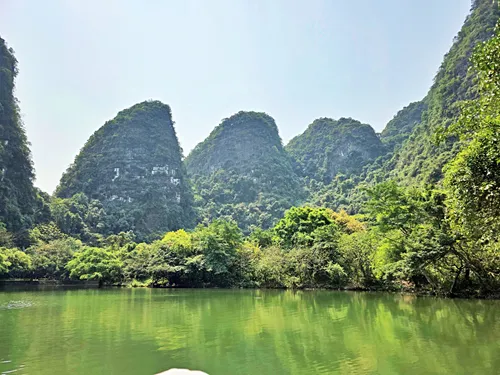
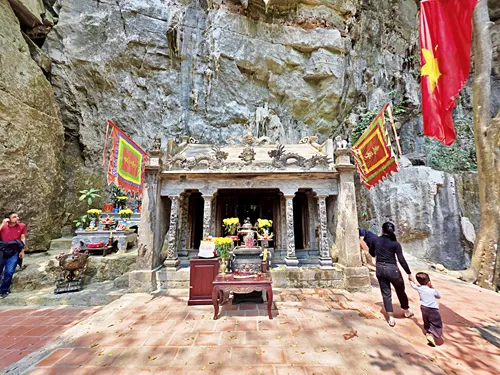
Hang Ba Giọt (Three-Drop Cave)
The name of the cave ‘Ba Giọt’ means ‘Three Drops’, and comes from the steady trickle of water that drips from its ceiling deep within the mountain, believed to represent three sacred drops of blessing: love, health, and prosperity.
Here are some photos that we took:
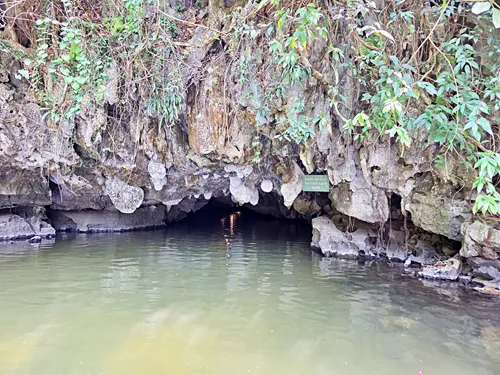
Hang Seo Cave
The name Hang Seo (literally translates to ‘West Cave’ (Hiệ Nguyễn from Sino-Vietnamese Tây for ‘west’). Compared to more ornate caves like Hang Sang or Hang Toi, Hang Seo offers a quieter, contemplative atmosphere.
Here are some photos that we took: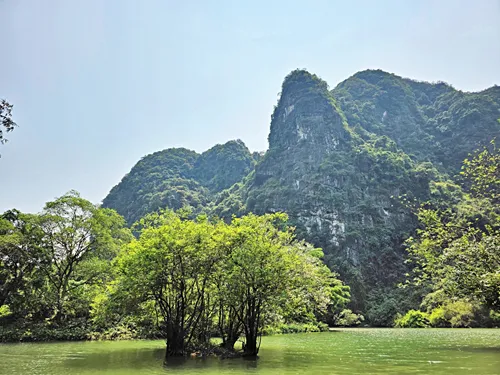
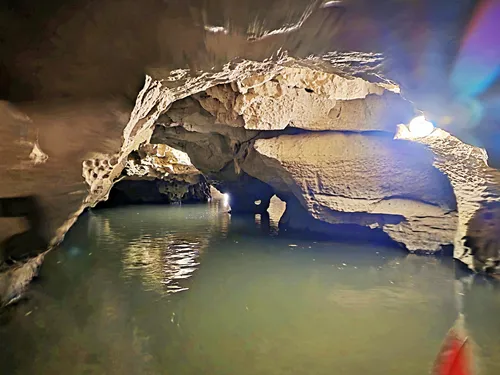
Hang Sơn Dương (Sơn Dương Cave)
The name ‘Sơn Dương’ can be translated as ‘Mountain Goat’, an animal that in Vietnamese folklore represents resilience, independence, and the ability to thrive in harsh, steep terrain. The goat is also considered a spiritually neutral creature, bridging wild nature and domestic life — thus symbolizing harmony and adaptability. Because the cave is one of the darker and more confined spaces on Route 1, some Vietnamese interpret it as a ‘womb-like’ passage — a return to origin before spiritual rebirth as the journey continues toward temples and light-filled valleys. The very act of moving through Sơn Dương is seen as a ritual of humility and purification, reinforcing the meditative rhythm of the Trang An experience.
Here are some photos that we took: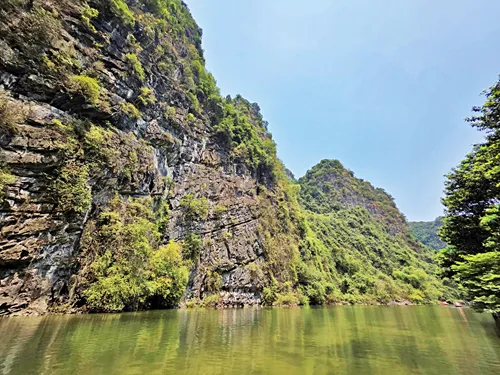
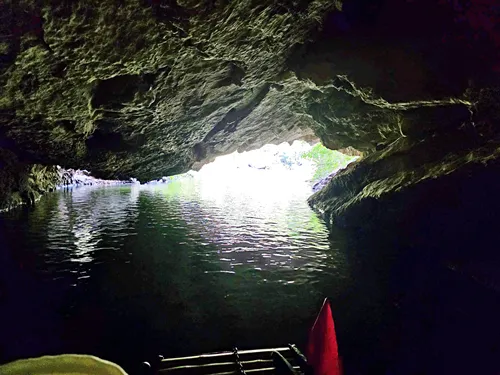
Phủ Khống Temple (Khống Temple)
Phủ Khống Temple is especially significant for its role in commemorating seven loyal mandarins of the Đinh Dynasty. According to historical accounts and local legend, when King Đinh Tiên Hoàng died in the 10th century, these seven high-ranking court officials, bound by loyalty and honor, chose to commit ritual suicide rather than serve a new ruler. Their devotion is seen as a rare and noble act of total fidelity and self-sacrifice.
The temple was built at the foot of the limestone mountain, at the mouth of Hang Khống, to enshrine the spirits of these seven mandarins. Inside, you will find a small but dignified altar space, usually maintained with fresh offerings of incense, flowers, and food. The layout is modest and deeply atmospheric, nestled against the natural rock and surrounded by thick jungle—a setting that emphasizes humility, devotion, and connection with nature.
Culturally, Phủ Khống Temple embodies key values in Vietnamese Confucian and spiritual traditions: Loyalty to the sovereign, Faithfulness beyond death, and Collective memory and ancestral worship.
Locals and pilgrims often visit to pay respect to these mandarins, praying for moral strength, loyalty in personal relationships, and clarity of purpose. In modern Vietnam, the story continues to resonate as a reminder that true loyalty and sacrifice are timeless virtues.
The location itself feels secluded and sacred—surrounded by limestone cliffs, accessible only by boat, and without the trappings of modern religious sites.
Here are some photos that we took: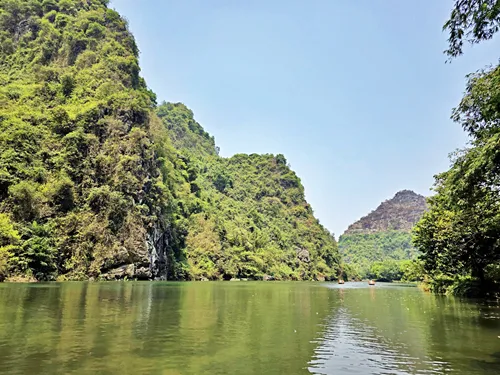

Hang Trần (Trần Cave)
Hang Trần is closely linked both geographically and spiritually to Đền Trần (Trần Temple), which honors the legendary general Trần Hưng Đạo, a national hero who led Vietnam to multiple victories against the Mongol invasions in the 13th century. The cave, whose name bears the general’s family name ‘Trần’, is thought to symbolize the strength, resolve, and strategic cunning that Trần Hưng Đạo embodied.
Though not as long or dramatic as some other caves on the route, Hang Trần serves a symbolic threshold, a natural passage near the sacred space where the spirit of the general is honored. In Vietnamese spiritual geography, caves often represent wombs of the earth or gateways between worlds, and Hang Trần can be seen as a liminal space linking the physical world to the spirit of the nation's defenders.
Here are some photos that we took: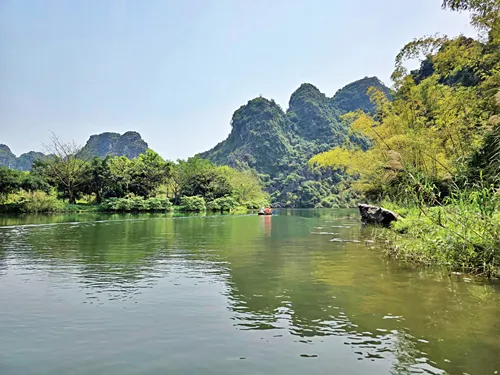

Hang Quý Hậu (Quý Hậu Cave)
Hang Quý Hậu takes its name from the Vietnamese term ‘Quý Hậu’, which traditionally refers to a noblewoman or royal consort in a feudal court. While there is limited direct historical documentation about a specific consort associated with this cave, local oral traditions suggest it is dedicated to or named in honor of a high-ranking female figure of the royal court, possibly one who lived during the time of the Đinh or Trần dynasties.
As such, the cave holds cultural value as a symbol of feminine virtue, loyalty, and spiritual presence. In Vietnamese tradition, royal consorts were often seen not only as wives or companions of kings but also as quiet custodians of the court’s harmony and spiritual balance. Their contributions, though often hidden from the battlefield or the political arena, were deeply revered.
The act of passing through Hang Quý Hậu is thought to be an encounter with quiet strength and nurturing wisdom, and some interpret the cave as a sanctified feminine space, an echo of Vietnam’s many mother goddess traditions, where women serve as intermediaries between heaven and earth.
Here are some photos that we took: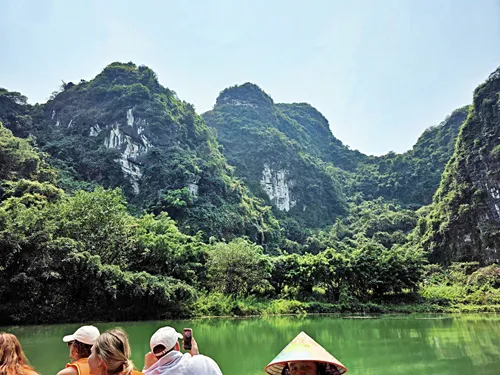
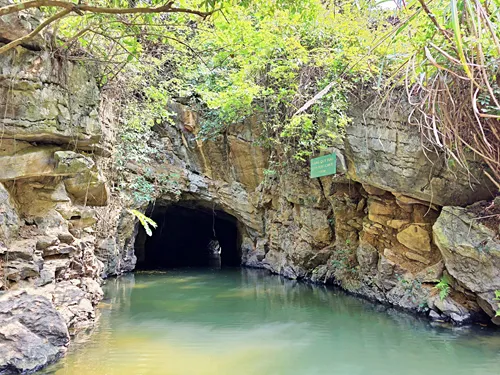
Summary
Route 1 is the most comprehensive and traditional, ideal for first-time visitors and history lovers. It includes more temples than other routes and focuses on the cultural and spiritual dimensions of Trang An.
Route 2: The Cave Lover’s Adventure
Duration: 2 to 2.5 hours
Caves visited: 4 caves
Temples visited: 3 temples
Best for: Those who want longer cave passages and fewer stops, ideal for nature photographers and cave enthusiasts
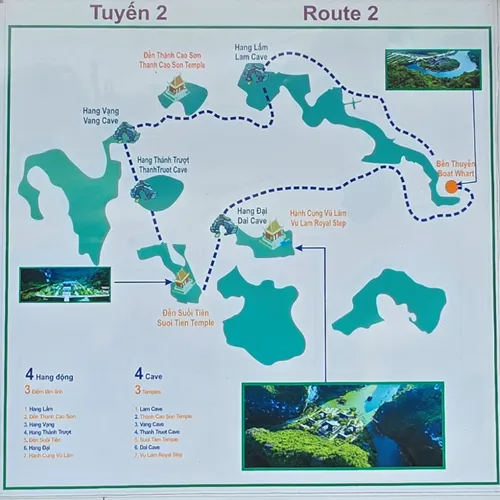
Hang Lam (Blue Cave)
Hang Lam, whose name ‘Lam’ means ‘blue’ or ‘deep forest’ in Vietnamese, holds symbolic significance related to serenity, elemental balance, and emotional clarity. In traditional Vietnamese cosmology, the color blue or greenish-blue (lam) is associated with water, tranquility, and renewal.
The cave’s narrow, shadowy interior and gently dripping water evoke the feeling of entering a sacred, untouched space, where time slows and the outside world falls away. The experience of gliding through Hang Lam is often likened to a passage into the subconscious, where quiet reflection is encouraged. The cave’s ambiance encourages mental purification and release from worldly distractions, offering a sense of calm and spiritual centering.
In Vietnamese folk spirituality, natural caves like Hang Lam are often thought to house local earth spirits (thần núi or thần đất), especially in areas surrounded by water and forest. As a result, Hang Lam is sometimes viewed as a kind of spiritual retreat, a place to reconnect with elemental forces and restore personal balance. The echoing acoustics, cool air, and filtered light create an immersive atmosphere that feels sacred and introspective.Tản Cao Sơn Temple
The temple honors Cao Sơn, who is believed to be the protector of the mountains, forests, and rivers, and who ensures the balance and harmony of the natural world. In Vietnamese cosmology, mountain gods are often associated with both fertility and protection, overseeing the landscape and helping to sustain the local agricultural life.
This temple is part of a broader mountain spirit cult that venerates natural deities as guardians of land and community. The worship of mountain gods like Cao Sơn is common throughout Vietnam, especially in rural areas where people rely heavily on natural resources for survival. Worshippers visit this temple to ask for protection from natural disasters, prosperity in farming, and peace for their families.
The spiritual practice here is a blend of local animism and ancestor worship, which ties together earthly sustenance and ancestral connection. Tản Cao Sơn Temple is often visited by those seeking blessings for good harvests and fertility, especially when the rice fields are being planted or harvested.Hang Vạng (Golden Cave)
‘Vạng’ refers to a golden hue, symbolizing wealth and illumination. Spiritually, gold in Vietnamese tradition does not only mean material fortune, but it also signifies enlightenment, divine radiance, and moral virtue. Locals believe that passing through the golden cave bestows fortune and joy.
Tản Trượt Temple
Tản Trượt Temple is dedicated to the spirit of the Tản Trượt Mountain. This mountain is believed to house a guardian deity who is often associated with the safety and well-being of local communities. In particular, the temple’s location and the god it honors are linked to protection against natural disasters such as floods and storms, which are of great concern to those living near the rivers and fields of Ninh Bình.
The deity honored at Tản Trượt Temple is seen as a protector of both land and water, ensuring that agricultural cycles can proceed without interruption and that communities remain safe from the frequent natural disasters that are common in the region. Because of its location along the river, the temple has historically been a place of prayers for safe and bountiful harvests, where local farmers seek blessings for fertility and prosperity for their crops.Suối Tiên Temple (Fairy Spring Temple) – part of Route 2 and Route 3
Suối Tiên Temple, also known as the Fairy Spring Temple. The temple is set in a picturesque location beside a natural spring, surrounded by lush greenery and limestone cliffs. It is deeply linked to the local legends of fairies and immortal beings, a common theme in Vietnamese mythology, where the natural world is often seen as inhabited by celestial entities.
The legend of the Fairy Spring suggests that the spring’s waters were once visited by immortal fairies, who would come down from the heavens to bathe and refresh themselves in the cool waters. These fairies are thought to embody the ideal balance between heavenly beauty and earthly grace, and their presence is believed to bring peace, purity, and good fortune to the land.
Locally, Suối Tiên Temple is a sacred place where visitors come to pray for blessings related to fertility, beauty, and spiritual harmony. It is particularly significant for those seeking inner peace, as it is said that the temple and its surrounding nature have a calming, purifying effect on the mind and soul. Pilgrims visit here to wash away negative energy, renew their spiritual path, and ask for help with personal and familial issues.
Additionally, the temple is associated with the feminine divine and the spirit of the natural world, reinforcing the connection between women, nature, and prosperity. The idea that fairies or celestial beings would visit this spring ties into the broader concept of nature being a living force, where water, in particular, is considered both sacred and life-giving.Hang Đại (Dai Cave) – part of Route 2 and Route 3
The name ‘Đại’ means ‘grand’ or ‘large’, and this cave lives up to its name with a wide, open entrance and a cavernous interior. It is often regarded as a symbol of spiritual awakening and personal growth due to its impressive size and the sense of expansion visitors feel as they enter.
In Vietnamese tradition, large caves like Hang Đại are thought to represent the womb of the earth, a place of origin, transition, and rebirth. For many pilgrims, passing through this cave symbolizes a spiritual journey of enlightenment. The large, open space within the cave is believed to offer a sense of freedom and clarity, allowing visitors to reflect deeply on their life's path and connect with their inner selves.
The cave's breathtaking expanse and the cool, still air inside are seen as creating a sacred space where one can recharge mentally and spiritually. The formation of the cave, with its high ceilings and natural rock walls, also reinforces the idea of nature as a force of great power and protection. Just as the cave stands resilient against the forces of erosion and time, it symbolizes endurance and inner strength.Vũ Lâm Royal Step – part of Route 2 and Route 3
This site is not a temple or cave but is instead a natural formation of steep, rock-hewn steps that lead to a plateau where the Vũ Lâm royal court once held important meetings and ceremonies during the early Đinh Dynasty.
Vũ Lâm itself is deeply tied to the founding of the Đinh Dynasty in the 10th century, which marked the consolidation of Vietnamese independence from Chinese rule. The steps were originally constructed as a way to reach the Vũ Lâm Palace, a royal compound where the Emperor Đinh Tiên Hoàng is believed to have conducted key military and political affairs. This historical connection makes the Vũ Lâm Royal Step a symbol of political power, unity, and national identity.
Spiritually, the Vũ Lâm Royal Step represents the ascent to higher understanding, both politically and spiritually. In Vietnamese culture, ascending steps, whether physical or metaphorical, are often seen as a process of transformation and elevation. The climb is a powerful metaphor for spiritual growth and elevating one’s status, whether through virtue, wisdom, or service to the country.
Summary
Route 2 is perfect for visitors seeking cave exploration over religious sites. While fewer temples are included, the caves here are larger, more dramatic, and make for excellent photography opportunities.
Route 3: The Scenic & Photogenic Route
Duration: 2 to 2.5 hours
Caves visited: 3 caves
Temples visited: 3 temples
Best for: Travelers wanting a balanced experience with picturesque views, moderate temples, and an easy pace
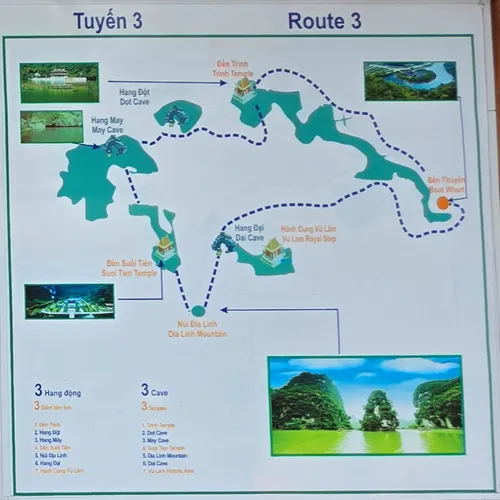
Trình Temple
Dedicated to General Nguyễn Minh Không, a revered figure in Vietnamese history and medicine, Trình Temple is one of the oldest and most venerated temples in the Trang An Complex. It symbolizes loyalty to the Đinh kings, ancestral worship, and the enduring presence of guardianship in Vietnamese cosmology. Locals still make offerings here for protection and healing.
Hang Đột (Đột Cave)
Hang Đột, often translated as ‘Breakthrough Cave’ or ‘Penetrating Cave’, with the word ‘đột’ in Vietnamese meaning breaking through obstacles, which gives this cave a powerful metaphorical association with overcoming personal challenges, achieving insight, and spiritual release.
Culturally, caves like Hang Đột are interpreted not merely as geographic features but as liminal spaces, thresholds between worlds. In Vietnamese folk belief, such spaces are ideal for spiritual transformation. Passing through Hang Đột can be seen as a ritual of emergence, a symbolic journey through darkness toward illumination or clarity. For this reason, some local boat guides and pilgrims consider Hang Đột a place where visitors can shed past burdens and emerge renewed.
Its winding form and shadowy interior make the cave feel mysterious and introspective, encouraging silence and reflection. The echo of dripping water within the cave reinforces the theme of slow, persistent change, a reminder that even the smallest forces can reshape the strongest stone, just as time and effort reshape one’s inner self.Hang May Cave (Cloud Cave)
Named for the mist (clouds) that frequently hover near its mouth, Hang May evokes the spiritual realm between earth and sky. In Vietnamese cosmology, clouds are messengers between humans and deities. Passing through this cave symbolizes communication with higher forces and mental elevation.
Suối Tiên Temple (Fairy Spring Temple) – part of Route 2 and Route 3
Suối Tiên Temple, also known as the Fairy Spring Temple. The temple is set in a picturesque location beside a natural spring, surrounded by lush greenery and limestone cliffs. It is deeply linked to the local legends of fairies and immortal beings, a common theme in Vietnamese mythology, where the natural world is often seen as inhabited by celestial entities.
The legend of the Fairy Spring suggests that the spring’s waters were once visited by immortal fairies, who would come down from the heavens to bathe and refresh themselves in the cool waters. These fairies are thought to embody the ideal balance between heavenly beauty and earthly grace, and their presence is believed to bring peace, purity, and good fortune to the land.
Locally, Suối Tiên Temple is a sacred place where visitors come to pray for blessings related to fertility, beauty, and spiritual harmony. It is particularly significant for those seeking inner peace, as it is said that the temple and its surrounding nature have a calming, purifying effect on the mind and soul. Pilgrims visit here to wash away negative energy, renew their spiritual path, and ask for help with personal and familial issues.
Additionally, the temple is associated with the feminine divine and the spirit of the natural world, reinforcing the connection between women, nature, and prosperity. The idea that fairies or celestial beings would visit this spring ties into the broader concept of nature being a living force, where water, in particular, is considered both sacred and life-giving.Địa Linh Mountain
Địa Linh Mountain, roughly translates to ‘Sacred Earth’ or ‘Spiritually Potent Land’, with the term ‘Địa Linh’ being drawn from an old Vietnamese proverb:
‘Địa linh nhân kiệt’: ‘Where the land is sacred, great people arise’.
This saying reflects the belief that certain landscapes possess a kind of natural spiritual energy, a force that nourishes both the earth and the souls who live upon it.
In Vietnamese geomantic tradition (phong thủy), mountains like Địa Linh are considered to be sites where the earth's veins of energy (long mạch) concentrate. These are places where heaven and earth meet, and where natural power flows into the land, giving rise to strong communities, wise leaders, and spiritual insight. As such, Địa Linh Mountain is revered not just for its beauty, but for its life-giving energy, its auspicious location, and its mythic presence within the landscape.
Historically, areas like Địa Linh were often chosen for royal retreats, meditation, and sacred rituals, especially during the Đinh and Trần Dynasties, whose rulers valued places with strong geomantic potential. The mountain stands as a spiritual guardian in the Trang An complex, its towering presence watching over the valleys, rivers, and temples below.
Visitors today may not ascend the mountain, but simply drifting past it by boat is considered a blessing. Many believe that even being near Địa Linh can attract good fortune, sharpen intuition, and promote spiritual grounding. Locals often make quiet offerings or prayers when passing it, especially during the Tet holiday or before major life decisions.
In the broader cosmological view, Địa Linh Mountain represents the sacredness of the land itself, a reminder that Vietnam's spiritual heritage is deeply embedded in its geography, and that the landscape is not just scenery, but a living participant in the spiritual life of the people.Hang Đại (Dai Cave) – part of Route 2 and Route 3
The name ‘Đại’ means ‘grand’ or ‘large’, and this cave lives up to its name with a wide, open entrance and a cavernous interior. It is often regarded as a symbol of spiritual awakening and personal growth due to its impressive size and the sense of expansion visitors feel as they enter.
In Vietnamese tradition, large caves like Hang Đại are thought to represent the womb of the earth, a place of origin, transition, and rebirth. For many pilgrims, passing through this cave symbolizes a spiritual journey of enlightenment. The large, open space within the cave is believed to offer a sense of freedom and clarity, allowing visitors to reflect deeply on their life's path and connect with their inner selves.
The cave's breathtaking expanse and the cool, still air inside are seen as creating a sacred space where one can recharge mentally and spiritually. The formation of the cave, with its high ceilings and natural rock walls, also reinforces the idea of nature as a force of great power and protection. Just as the cave stands resilient against the forces of erosion and time, it symbolizes endurance and inner strength.Vũ Lâm Royal Step – part of Route 2 and Route 3
This site is not a temple or cave but is instead a natural formation of steep, rock-hewn steps that lead to a plateau where the Vũ Lâm royal court once held important meetings and ceremonies during the early Đinh Dynasty.
Vũ Lâm itself is deeply tied to the founding of the Đinh Dynasty in the 10th century, which marked the consolidation of Vietnamese independence from Chinese rule. The steps were originally constructed as a way to reach the Vũ Lâm Palace, a royal compound where the Emperor Đinh Tiên Hoàng is believed to have conducted key military and political affairs. This historical connection makes the Vũ Lâm Royal Step a symbol of political power, unity, and national identity.
Spiritually, the Vũ Lâm Royal Step represents the ascent to higher understanding, both politically and spiritually. In Vietnamese culture, ascending steps, whether physical or metaphorical, are often seen as a process of transformation and elevation. The climb is a powerful metaphor for spiritual growth and elevating one’s status, whether through virtue, wisdom, or service to the country.
Summary
Route 3 is best for those seeking a photogenic, gentle experience with fewer long caves. It is especially good for couples, families with children, or anyone who prefers less time in confined spaces.
After our boat tour, we have two more destinations for today:
Where do you want to go now?
Author: Rudy at Backpack and Snorkel
Bio: Owner of Backpack and Snorkel Travel Guides. We create in-depth guides to help you plan unforgettable vacations around the world.
Other popular Purple Travel Guides you may be interested in:
Like this Backpack and Snorkel Purple Travel Guide? Pin these for later:
